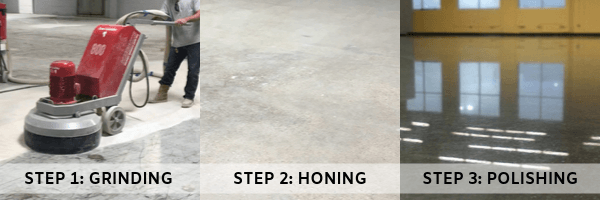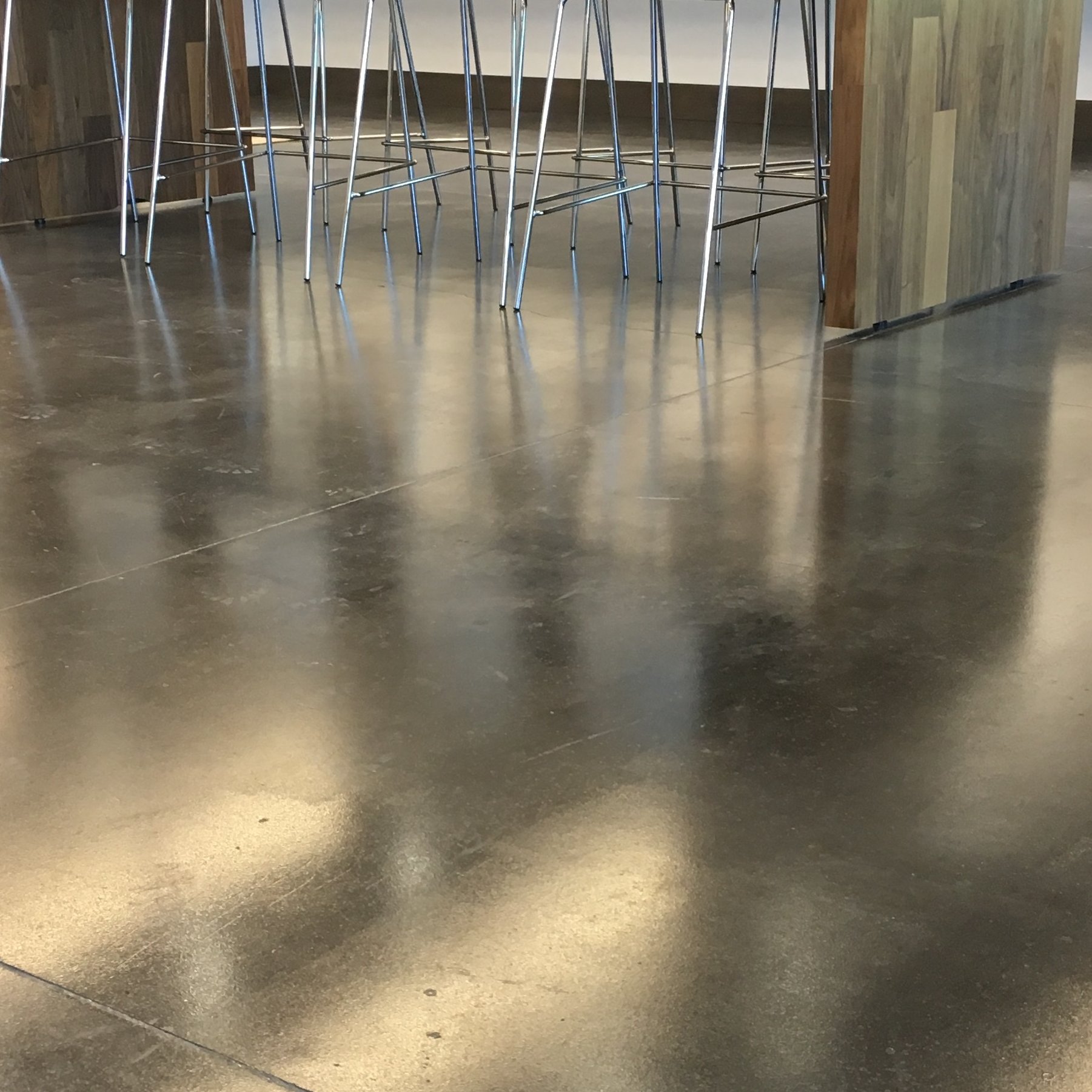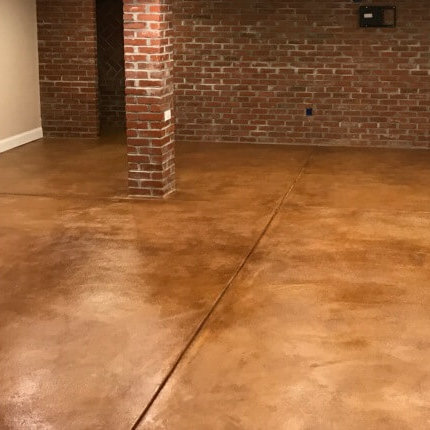Polished Concrete
USA Renovations has provided polished concrete services across the nation. Whether you are a general contractor or direct buyer, we want to work with you and provide the best-polished concrete service possible.
What is polished concrete?
Polished concrete is a multi-step process where a concrete floor is mechanically ground, honed and polished with bonded abrasives in order to cut a concrete floor’s surface.
Polished concrete floors are the latest trend in office spaces, retail spaces, manufacturers warehouses, airports, schools and event spaces. This is simply because they are easy to maintain, extremely cost effective, and have a beautiful mirror-like glossy finish to them that will outlast any other surface available on the market today.
There are a variety of options when choosing your polished concrete flooring, including the integral or penetrating stain color, the gloss level, and aggregate type. Our professionals will assist you in the processes used to reach the desired finish you request.
In simple terms, polishing concrete is similar to sanding wood. We utilize large industrial 1200 pound grinding machines that are equipped with a planetary system. This allows the grinder to hold a set (9) diamond-impregnated disks that are the size of a hockey puck. These pucks are impregnated with diamond fragments and categorized into grit ratings such as 100, 200, 400, etc. depending on how course or fine these pucks are will determine their overall grit rating.
Similar to sandpaper on wood, these disks are used to grind the concrete surface down to refinement and desired aggregate then brought back up in stages which are grinding, honing, and polishing until the desired level shine is achieved.
About this Process
We have several videos of the polished concrete process on our YouTube channel where you can watch one of our mechanical grinders live in action. To keep things simple, our process can be broken down into three main steps:
- Grinding
- Honing
- Polishing
Call For a Quote:
(877) 935-9411
F.A.Q.
We understand that you may have questions that come up regarding polished concrete. Let us help!
What is densifier and why does it matter?
Densifier is a key role in the process of polishing concrete. During the process, a penetrating chemical called “densifier” is applied. The chemical then sinks into the concrete as it chemically reacts, causing the surface to harden to a much higher surface PSI. This protects the concrete from the inside out while allowing the best possible polished concrete gloss rating. This eliminates the needs for a topical coating, reducing maintenance significantly.
How is concrete polished? What are the steps?
Step 1 – Grinding
Using coarse diamond segments which are bonded in a metallic matrix, minor pits, blemishes, light coatings or stains are removed from the floor. Most concrete floors begin with 50 Metal to 100 Metal. Then, lower or high grit segments are used to reach the desired finish. Grit segments are dependent on the owner’s selection in the initial planning phase.
Step 2 – Honing
Once the grinding process is finished and the desired surface is achieved, we switch to our Hybrid/Transitional Diamond Impregnated Segments. These finer resins and metal/resin matrix tooling pucks remove any of the aggressive abrasion left behind by our metal bond diamond segments. Anywhere from two to four steps follow, ranging from 50 hybrid (metal and resin hybrid) to 200 resins. From there, we enter into the polish process.
Step 3 – Polishing
The polish process begins at 400-1500 Grit Diamond Impregnated Resin Segments. This process will continue with progressively finer grits until the preferred gloss is reached.
What are the benefits of polished concrete?
Polished concrete floors continue to be popular for several reasons, all of which include:
- Low maintenance: in high traffic areas such as commercial buildings or office spaces, having low maintenance floors is a necessity. To keep polished concrete floors clean and “like new”, all it needs is mopping using a dust mop on a regular basis, using cleaning product semi-regularly. There’s no need for messy coatings such as wax. Labor costs are cut when compared to wood or carpet flooring because polished concrete requires less cleaning time.
- Long term durability: foot traffic from employees or customers, forklifts, carts, etc. can be harmful to many surfaces and demand replacement every 5 – 7 years.
- Free from moisture transmission issues: Alternative flooring options such as tile, wood or carpet leads to issues such as adhesive deterioration, bumps, ridges, color changes, mold, bacteria growth, peaking or curling, all caused by sealing of the floor, not allowing it to breathe. Polished concrete floors simply don’t have these issues.
- Efficient long-term floor: Going green or simply want to do your part in making your business or home eco-friendly? Polished concrete is a great flooring option for sustainability. When left exposed, concrete floors have two functions: they are the foundation slab along with the finished flooring. By eliminating the need for wood, carpet or tile, you save resources that would eventually need replacing.
- Enhanced Lighting While Saving Energy: one of the nicest qualities of polished concrete is the mirror-like, glossy reflection which becomes a benefit to your energy bill. Upon completion 25 – 30% less lighting is necessary due to the high reflectivity of the polished concrete. This not only reduces the lighting needed but will noticeably reduce the demand on HVAC units due to less heat generated by lighting
- Go Green! Earn LEED Credits: Recycle old concrete floors or start fresh with polished concrete which can earn up to 5 LEED Credits. The Leadership in Energy and Environmental Design has listed polished concrete as a LEED certified project. Whether it be a reduction of adhesives by eliminating wood or carpet tile or optimizing energy performance due to less requires lighting we can help you earn LEED Credits and Go Green!
What are gloss levels?
According to the Concrete Polishing Association of America (CPAA) there are 2 ways to classify a final polished concrete finish. Below is a how our professionals measure Gloss and Aggregate:
The level of gloss is the rating in which a finish concrete slab reflects the ambient light. It is what gives polished concrete its sheen. Our professionals are skilled in achieving 4 main levels of gloss.
LEVEL 1 GLOSS – can usually be obtained at the 100-grit resin bond. The concrete surface will appear as if it’s a smooth but hazy finish with little to no reflection. This level is most common in warehouses.
LEVEL 2 GLOSS – is accomplished by using the 400-grit resin bond. The concrete surface will have a low-sheen finish, producing a slight overhead reflection when looking at the floor from an angle. This has also been considered a low-luster matte finish.
LEVEL 3 GLOSS – is obtained using the 800-grit diamond abrasive. At this level, you’ll be able to see light reflectivity and from 30-50 feet, the floor will clearly reflect overhead and side lighting.
LEVEL 4 GLOSS – is obtained using a 1500 – 3,000 grit resin bond diamond or by using a high-speed burnisher outfitted with specialty buffing pads. At this level, you accomplish a high degree of shine and reflectivity. Reflections have a high level of clarity and the floor almost appears wet from different visual angles. This level is most selected for retail outlets, office spaces or customer-facing businesses.
What are aggregate classes?
According to the Concrete Polishing Association of America (CPAA) there are 2 ways to classify a final polished concrete finish. Below is a how our professionals measure Gloss and Aggregate:
CLASS A AGGREGATE – very little is removed from the surface to achieve this aggregate class. Specifying this aggregate class will yield none to very little aggregate exposure.
CLASS B AGGREGATE – approximately 1/16th inch of the surface is ground down to reach this class of aggregate. Specifying this class of aggregate will yield fine aggregate exposure with little or no medium aggregate exposure at random locations. This is also known as a “salt and pepper” finish. This is the most common finish among all industries as it can achieve a better gloss than a Class “A” aggregate as most slabs still require additional finishing/refinement thus requiring more aggressive diamond segments to work out any imperfections. As a result, the additional refinement leads to a deeper cut resulting in the Class B aggregate.
CLASS C AGGREGATE – approximately 1/8th inch of the surface is ground down to reach this class of aggregate. Specifying this class of aggregate will yield medium aggregate exposure with little or no large aggregate exposure at random locations. This class enters into a more specialty finish with additional aggregate exposure. This additional contrast of smaller and larger rocks gives off a very beautiful appearance. Additional grinding time is required to achieve this level of aggregate.
CLASS D AGGREGATE – approximately 3/16th to 1/4th inch of the surface is ground down to reach this class aggregate. Specifying this class of aggregate will yield large aggregate exposure with little or no fine aggregate exposure at random locations. This is by far the most contrasted class aggregate that can be achieved. This class of slab has been achieved in museums and high-end retail outlets. Our professionals have rated the Class D Level 4 slab as our best-polished concrete finish available today.
Related Services
Sealed Concrete
Sealing brings out the beauty of a concrete floor by enhancing the color and adding sheen. Sealing also preserves the decorative treatment.
Stained Concrete
With its warm and inviting appearance, Stained Concrete will continue to be a top pick within the concrete finishes sector.
Epoxy Flooring
A top pick for decades for those projects that demand a strong floor, epoxy will seal and protect the surface from chemicals or blunt force.



